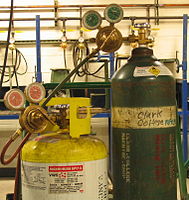
Photo from wikipedia
Abstract Structural steel connections are highly susceptible to damage due to long-term effect such as missing or loosening of bolts along with corrosion, fatigue, accidental loads etc. throughout their service… Click to show full abstract
Abstract Structural steel connections are highly susceptible to damage due to long-term effect such as missing or loosening of bolts along with corrosion, fatigue, accidental loads etc. throughout their service life. The existing local connection damage identification methods require expensive instrumentation and the sensors at a specific location. That is why, artificial intelligence (AI) has become very popular and has come up with better alternatives, efficiency which can overcome the shortcomings of traditional vibration-based connection damage identification techniques. As per the current literature, most of the AI-based techniques that use experimentally generated damage data suffer the paucity of appropriate and quality dataset corresponding to different damage conditions. Hence the authors have proposed a model-based scheme for evaluating the health condition of steel structural connection in such cases, which uses a combination of Convolutional Neural Network (CNN) and Continuous Wavelet Transform (CWT) of the response signal. The method requires only global vibration signals from impulse excitation on the structure and subsequently the updated finite element (FE) model of steel structure considering connection flexibility can be utilized for multiple functionalities. For experimental validation of the proposed methodology, a two-story structural steel frame has been considered. The performance of the proposed methodology is further verified and validated through the identification of beam-column connection damage additionally introduced in the test frame.
Journal Title: Journal of building engineering
Year Published: 2020
Link to full text (if available)
Share on Social Media: Sign Up to like & get
recommendations!